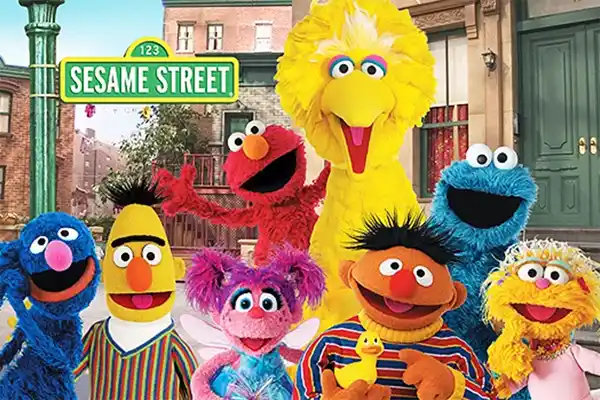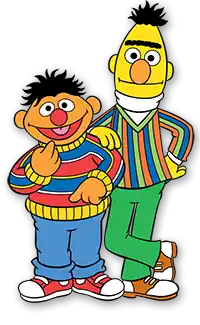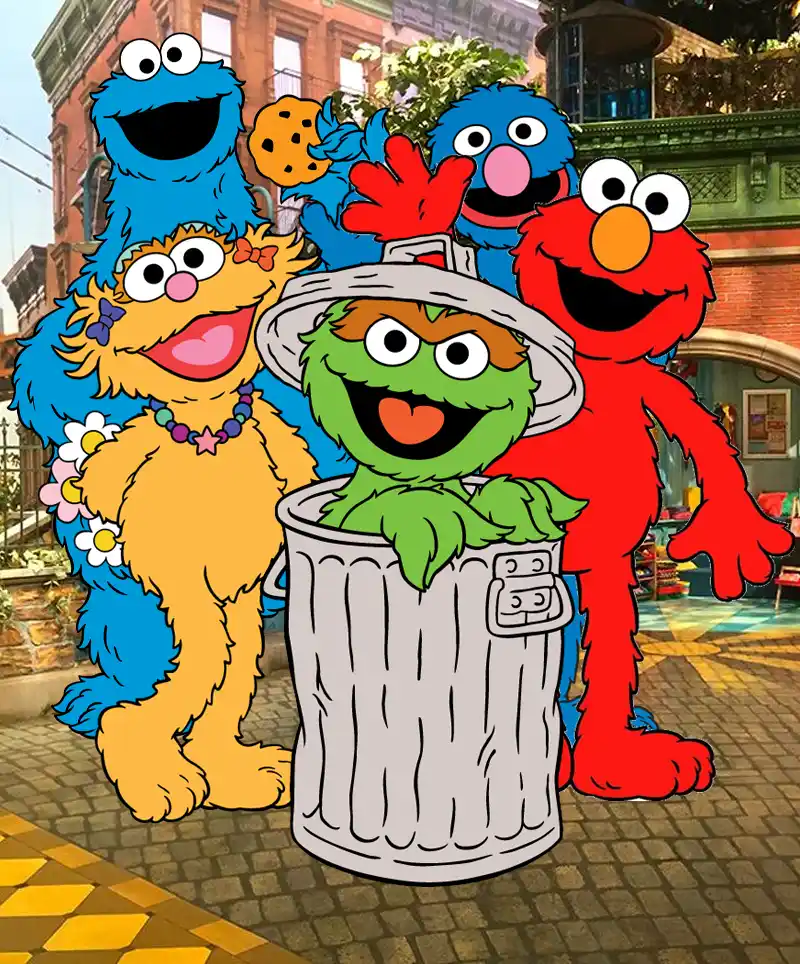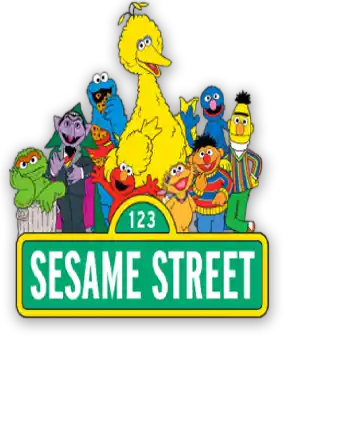Celebrating the World’s Most Beloved Street
Every year on November 10th, we celebrate Sesame Street Day, a day dedicated to the educational powerhouse that has been teaching children (and let’s be honest, adults too) how to count, spell, and treat others with kindness since 1969. Created by the visionary Joan Ganz Cooney and the creative genius Jim Henson, Sesame Street has been a staple in households worldwide for over five decades, bridging gaps in learning and making monsters, birds, and grouches beloved friends. It’s a day to appreciate the laughter, lessons, and lasting memories this show has brought to our lives.
A Different Kind of Classroom
In the 1960s, early childhood education was gaining attention, and a group of educators, psychologists, and TV producers saw the potential of television as a teaching tool. Their mission was bold: create a show that could reach young children in urban areas who lacked access to quality preschool programs. The team wanted a program that was educational, inclusive, and, most importantly, fun. Thus, Sesame Street was born, turning TV into a classroom where monsters and humans taught side by side.
The first episode aired on November 10, 1969, and instantly captured the hearts of children and parents alike. The show introduced us to Big Bird, Oscar the Grouch, and Cookie Monster, making it clear that learning could be anything but boring.
Sesame Street made its mark by featuring an unforgettable lineup of characters, each with a personality that taught kids something unique. Let’s take a look at some of our “professors” on Sesame Street University:
-
Big Bird – Standing at eight feet tall, Big Bird is everyone’s gentle giant. With a curious nature and a bit of innocence, he embodies the joy of discovery, showing kids that it’s okay not to know all the answers—as long as you’re willing to ask questions.
-
Oscar the Grouch – Living in a trash can and delivering complaints on the hour, Oscar is the show’s lovable pessimist. His message? Emotions are okay—even grumpy ones—and you don’t always have to be chipper. Plus, he’s proof that you can live in a trash can and still have a heart of gold (under all the grumpiness).
-
Cookie Monster – Obsessed with cookies, Cookie Monster has taught generations that self-control is an ongoing journey. He’s our beloved example of struggle and triumph over temptation (sort of), and his catchy "C is for Cookie" song is probably still stuck in our heads.
-
Grover – Known for his boundless enthusiasm and somewhat klutzy heroics, Grover shows that it’s okay to make mistakes. His alter ego, Super Grover, might not save the day as gracefully as Superman, but he tries with a heart of gold (and usually a stumble or two).
-
Elmo – The friendly red monster with a contagious giggle, Elmo teaches compassion and emotional intelligence, showing kids how to manage and express their feelings. Fun fact: Elmo’s popularity skyrocketed so much in the ‘90s that he almost single-handedly created a toy-buying frenzy with “Tickle Me Elmo.”
-
Count von Count – The show’s resident vampire is not out for blood; he’s out for numbers! Count von Count has probably taught more kids to love numbers than all of our math teachers combined. Obsessed with counting, he’s proof that numbers can be thrilling, even without a calculator.
Education and Entertainment in Perfect Harmony
One of Sesame Street's secret weapons has been its unique format: a mix of animation, puppetry, and live-action segments that cater to short attention spans while delivering powerful lessons. Each episode packs in skits, songs, and guest appearances, with frequent celebrity drop-ins. Everyone from Stevie Wonder to Michelle Obama has made an appearance, adding a little extra sparkle and showing kids that they’re in good company on Sesame Street.
 By blending humor with serious topics, the show has covered a wide range of themes, from the alphabet to racial equality. For instance, in 1983, the show tackled the sensitive subject of Mr. Hooper’s death, offering children a way to process loss with compassion and honesty.
By blending humor with serious topics, the show has covered a wide range of themes, from the alphabet to racial equality. For instance, in 1983, the show tackled the sensitive subject of Mr. Hooper’s death, offering children a way to process loss with compassion and honesty.
The Science Behind the Street
Sesame Street isn’t just a happy accident; it’s backed by a massive amount of research. The show uses what they call the “Sesame Workshop Model,” which includes research and testing with children to ensure every scene is effective. They’ve consulted child psychologists, educators, and parents to make sure every episode resonates with kids’ developmental stages. Even the pacing of scenes, the color choices, and the types of words used are carefully selected to match young minds' needs.
In fact, studies have shown that children who regularly watch Sesame Street perform better in school. Kids learn letters, numbers, and even soft skills like empathy and patience. It’s the ultimate sneaky teaching tool, and parents get to feel pretty great about letting their kids indulge in a little extra screen time.
One of the most impressive aspects of Sesame Street is its global reach. The show has been adapted into over 150 versions worldwide, each with its own culturally relevant characters. In South Africa, for example, Takalani Sesame introduced Kami, an HIV-positive Muppet, to teach children about the virus in a compassionate and age-appropriate way. In Afghanistan, a young girl character named Zari was introduced to promote gender equality. Sesame Street isn’t just about ABCs and 123s—it’s about addressing real-world issues with kindness and empathy, giving children around the world lessons in both learning and life.
Memorable Moments
Over the years, Sesame Street has delivered countless unforgettable moments:
-
Mr. Hooper’s Goodbye: When Mr. Hooper, the kindly store owner, passed away, the show addressed death in a way that was honest yet comforting, helping children understand that people may leave, but memories remain.
-
The Alphabet Song Collabs: Some of the world’s most famous musicians—from Stevie Wonder to Destiny’s Child—have appeared to sing the alphabet with the Muppets. And let’s face it, they made it unforgettable.
-
Kermit’s News Flash: Kermit the Frog as a roving reporter added a layer of humor that even parents could enjoy. His “News Flash” segments were a delightful take on storytelling, especially since Kermit often found himself in rather “interesting” situations.
-
Grover’s “Near and Far”: Who knew that distance could be so hilarious? Grover’s exaggerated demonstrations of “near” and “far” were a fan favorite, teaching kids about spatial awareness in the goofiest way possible.
How to Celebrate Sesame Street Day
Celebrating Sesame Street Day is as easy as A-B-C:
-
Watch Some Classic Episodes – Revisit the golden days with classic episodes or enjoy newer ones with the whole family. You might find that the jokes hit differently as an adult!
-
Have a Sesame Street Marathon – Stream a lineup of episodes featuring favorite characters. It's the perfect excuse to binge-watch with purpose.
-
Make Monster Snacks – Bake cookies like Cookie Monster or create fruit snacks with eyes to make them “monster-friendly.” Bonus points if you try eating like Cookie Monster, crumbs everywhere!
-
Dress Up as a Character – Pull out the dress-up box, grab some feathers for Big Bird, or stick some googly eyes on a shirt to channel your inner Elmo. It’s fun for all ages.
-
Learn with the Kids – Use the Sesame Street website or apps to explore games and activities that bring the characters to life. Sesame Street has loads of educational resources to keep learning going.
-
Practice Counting Everything – Channel your inner Count von Count and find ways to incorporate counting into daily life. Count the steps to the mailbox, the number of cupcakes you’re eating, or how many times you’ve hummed the Sesame Street theme song today.
 At its core, Sesame Street is about more than ABCs and 123s; it’s about teaching kindness, respect, and understanding. For over 50 years, this show has been a friend to children, a resource for parents, and a bridge across cultural divides. It’s inspired countless kids to learn, laugh, and see the world through a lens of acceptance.
At its core, Sesame Street is about more than ABCs and 123s; it’s about teaching kindness, respect, and understanding. For over 50 years, this show has been a friend to children, a resource for parents, and a bridge across cultural divides. It’s inspired countless kids to learn, laugh, and see the world through a lens of acceptance.
So, let’s celebrate Sesame Street Day with a big smile, a few laughs, and maybe a little singalong. Because, just like the theme song says, it’s a place “where the air is sweet” and where lessons for life are as easy as A-B-C.
Please Share our Content






 By blending humor with serious topics, the show has covered a wide range of themes, from the alphabet to racial equality. For instance, in 1983, the show tackled the sensitive subject of Mr. Hooper’s death, offering children a way to process loss with compassion and honesty.
By blending humor with serious topics, the show has covered a wide range of themes, from the alphabet to racial equality. For instance, in 1983, the show tackled the sensitive subject of Mr. Hooper’s death, offering children a way to process loss with compassion and honesty. At its core, Sesame Street is about more than ABCs and 123s; it’s about teaching kindness, respect, and understanding. For over 50 years, this show has been a friend to children, a resource for parents, and a bridge across cultural divides. It’s inspired countless kids to learn, laugh, and see the world through a lens of acceptance.
At its core, Sesame Street is about more than ABCs and 123s; it’s about teaching kindness, respect, and understanding. For over 50 years, this show has been a friend to children, a resource for parents, and a bridge across cultural divides. It’s inspired countless kids to learn, laugh, and see the world through a lens of acceptance.








 "Sláinte!" is a traditional Irish expression used as a toast, equivalent to "Cheers!" in English.
"Sláinte!" is a traditional Irish expression used as a toast, equivalent to "Cheers!" in English.